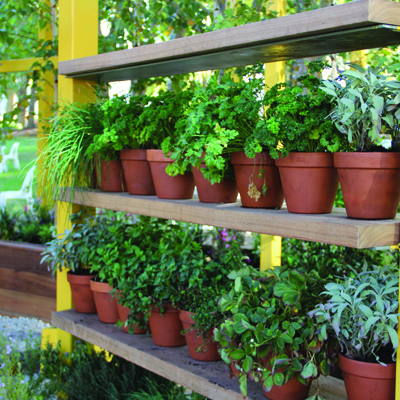
For those with limited space or difficult conditions, growing edible plants in containers is an ideal solution. With containers, you can make the most of a small space, have complete control over the soil composition, and provide the optimal amount of water.
Getting started with container gardening is easy – it’s just a matter of choosing the right container, soil, and plants.
Which containers are best?
Despite what you may see on Pinterest and design blogs, if you want to grow edible plants, you need to have a container of a reasonable size – at least 30cm wide and 40cm depth as a bare minimum for annual vegetables and herbs and double that for dwarf fruit trees and shrubs. Many edible plants need room to establish a decent root system to gather the nutrients they will then put into their leaves, flowers, and fruits. Additionally, the smaller the pot, the faster it will dry out and deplete your plants of essential moisture, stunting their growth.
To further prevent unnecessary moisture loss, choose the right materials for your pots. Options for materials include:
Terracotta
Cheap and cheerful, terracotta is a favourite of many container gardeners. But it must have a sealant applied to the inside and outside of the pot to prevent it drying out.
Plastic
It might not be the most attractive of materials, but plastic is ideal for raising herbs and vegetables. Plastic retains moisture, is lightweight and generally won’t heat up too much.
Metal
Many metal containers can be adapted to edible cultivation, so long as they have provision for drainage and won’t leech harmful chemicals into the soil.
Contrary through it may sound, in addition to retaining moisture, containers must also have adequate drainage. Plants’ roots generally require an even mixture of water and air in the gaps in the soil, so all containers must be able to drain.
Which soil is best?
For the vast majority of plants, a good quality potting or container mix will be sufficient, particularly if you are kitting out several different types of plants in different containers. If you have any plants that a bit fussier about their soil (i.e. they like soil a bit more acidic or a very ‘hungry’ plants who need more fertiliser), you can simply add it to the mix.
It’s also advisable to add in a wetting agent or water storage granules if the potting mix doesn’t contain any, to prevent the soil from drying out too quickly.
Which plants are best?
Given the right pots and enough care and attention, the vast majority of edible plants will survive and even thrive in pots. If you’re just starting out, here’s our top three list to get you started:
1) Cut and Grow Leaves
Rockets, parsley, and perennial spinach are great for having in a pot near your kitchen and snipping off what you need for each meal – they couldn’t get any fresher.
2) Quick Growing Seeds
Growing plants from seeds is remarkably easy – and satisfying. Try radishes, cress, and mustard seeds to see plants come to life right before your eyes – and into your belly.
3) Small Fruits
Mini tomatoes, strawberries, and chillis all do exceptionally well in pots with a bit of care and attention. Be sure to provide some netting to keep the birds off.
Tender Loving Care
Edible plants in containers are almost like pets – they require daily attention. But, just like pets, if you love them, you won’t mind giving it to them.